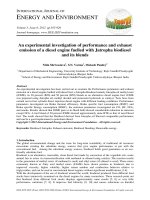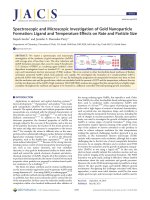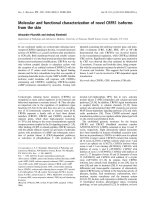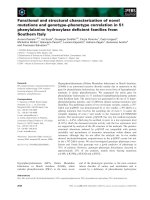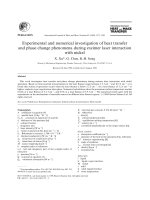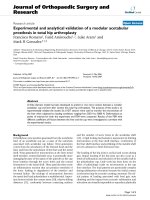Experimental and numerical investigation of novel pine oil biofuel in a diesel engine
Bạn đang xem bản rút gọn của tài liệu. Xem và tải ngay bản đầy đủ của tài liệu tại đây (21.98 MB, 156 trang )
EXPERIMENTAL AND NUMERICAL
INVESTIGATION OF NOVEL PINE OIL BIOFUEL
IN A DIESEL ENGINE
VALLINAYAGAM RAMAN
(B.Eng.), INDIA
A THESIS SUBMITTED
FOR THE DEGREE OF DOCTOR OF
PHILOSOPHY
DEPARTMENT OF MECHANICAL ENGINEERING
NATIONAL UNIVERSITY OF SINGAPORE
2014
DECLARATION
I hereby declare that the thesis is my original work and it has been written by
me in its entirety. I have duly acknowledged all the sources of information
which have been used in the thesis.
This thesis has also not been submitted for any degree in any university
previously.
Vallinayagam Raman
7 January 2014
ACKNOWLEDGEMENTS
At the outset, I would like to thank ALMIGHTY for having given the
mindset to embark on a research work and bestowing all praises on me for all
my endeavors. Providentially, I made my right choice to join the combustion
team, headed by Prof. S.K.Chou, who has been instrumental in the growth and
progress of the team throughout the pursuit of my Ph.D program. Without his
support and patronage, nothing could have been materialized and I shall
remain grateful to him throughout my life. The other members of the team
include Dr. Yang Wenming, Dr. Lee Poh Seng, Dr. Chua Kian Jon Ernest, Dr.
An Hui, Dr. Vedharaj Sivasankaralingam, Mr. Balaji Mohan, Mr. Mohammad
Fahd Ebna Alam, Mr. Amin Maghbouli and Ms. Li Jing. I sincerely thank all
the members of my team, whose support and help have always been useful to
me in the prospects of improving my skills and grooming the interest
pertaining to my research. In a notable mention, I wish to render my warm
thanks to my supervisors, Dr. Lee Poh Seng and Dr. Chua Kian Jon Ernest, for
extending their moral support and liberty to accomplish my research ideas in
my own right. Finally, I desire to convey my special gratitude to Dr. Yang
Wenming, who has been the guiding light for me in all of my ventures. Known
for his adeptness in the field of my research, his technical suggestions and
guidance have molded me as a better researcher and with his association, we
left no stone unturned. Over and all, as a manifestation of our hard work and
perseverance, our team emerged triumphant by publishing many papers in
various international journals and wholeheartedly, I submit all my
developments and success to the team.
In the event of collaborating with IIT-Madras, I was able to establish
contact with Prof. V.Ganesan, one of the pioneers in the field of internal
combustion engines. Getting to work under his auspice is itself a treasure and I
proudly value our association than anything else. I wish to render my heartfelt
thanks to him for providing valuable suggestions and recommendations
pertaining to my Ph.D. work. After some initial hurdles with my progress in
research, collaboration with him had let me in the right direction and
everything fell in place because of his blessings and help. Further, I wish to
supplicate my immense thanks to Dr. C.G. Saravanan, Professor, Annamalai
Acknowledgements
ii
University, for helping me in carrying out many experiments using biofuels in
a diesel engine. His dynamism and vigor have always motivated me and
despite facing many ups and down during our study, we never got bogged
down and always held high spirits. I shall rather pledge my accomplishments
and glory to him. Similarly, I also thank Dr. Raghavan, Assistant professor,
IIT Madras, for lending support to conduct a fundamental study on droplet
evaporation and shedding technical guidance in conceiving a manuscript,
related to our study. I also take this opportunity to specially thank Mr. Ezhil
Raj, Mr. Prassana, Mrs. Vijayashree and all those from India who assisted me
throughout the course of my research work. In respect of technical writings
and correction of manuscripts, my friends and fellow researchers, Mr.
Meiyappan Lakshmanan and Mr. Balaji Mohan, provided me many inputs to
strengthen my writing prowess.
In the personal front, I wish to express my love and gratitude to my
parents, Mr. G.Raman and Mrs. R.Prema and my brother, R.Petchiappan, who
have always invigorated me to prosper higher. The increasing alacrity shown
by my parents towards my work and the encouragement given by them have
prodded me to excel in my areas of expertise. Significantly, my brother
remained as a technical solution provider and advisor to me in various aspects
of my research. Many thanks to him and other family members, especially my
grandparents, Mr. Annamalai and Mrs. A. Paravathy, with whom I had few
discussions with regards to the exploration of a novel biofuel, enabling me to
think in different dimension and explore a lot. Finally, I also wish to thank my
friend, R. Karthikeyan, for providing accommodation to me during my stay in
India and his residence turned out to be the birth place of many of my research
ideas. Also, I thank my other friends Prithivi Rajan, Kanagaraj, Jai Ganesh,
Babukanth, Anand kumar Raju, Sankaranarayanan and Karthik Raja for
motivating me in all research endeavors and other aspects of my life. Last but
not least, my fellow confederate and close pal, Dr.Vedharaj
Sivasankaralingam was always with me and instilled fresh hopes and
aspiration, enabling me to set my focus and sight in the right direction. Both
professionally and personally, we had struck a nice camaraderie and true sense
of this will always imbibe in me.
TABLE OF CONTENTS
1. INTRODUCTION 1
1.1. Crude oil crisis and surge in petroleum fuel price 1
1.2. Environmental degradation with the use of petroleum fuels 2
1.3. Development of alternate fuels 4
1.3.1. Biofuel - Promising alternate fuel for diesel engine 5
1.3.1.1. High viscous biofuels 5
1.3.1.2. Less viscous biofuels 7
1.4. Problem statement and research objectives 8
1.5. Research plan and outline 10
1.6. Novelty and significant contributions of the research work 13
2. LITERATURE REVIEW 17
2.1. Introduction 17
2.2. Composition and property analysis of less viscous fuels 19
2.2.1. Critical properties 20
2.2.2. Ignition properties 22
2.2.3. Evaporation properties 22
2.2.4. Atomization and spray properties 23
2.2.5. Fuel consumption properties 23
2.2.6. Stability and storage capabilities 24
2.2.7. Compositional attributes 25
2.3. Operational feasibility of less viscous fuels in blend fuel mode . 25
2.3.1. Blend fuel mode of operation for alcohols 25
2.3.2. Blend fuel mode of operation for eucalyptus oil 28
2.3.3. Summary and future recommendations 30
2.4. Operational feasibility of less viscous fuels in dual fuel mode 31
2.4.1. Dual fuel mode of operation for alcohols 31
2.4.1.1. Dual fuel mode of operation for methanol 32
2.4.1.2. Dual fuel mode of operation for ethanol 35
2.4.2. Summary and future recommendations 39
2.5. Operational feasibility of less viscous fuels in sole fuel mode 40
Table of contents
iv
2.5.1. Sole fuel mode of operation for alcohols 40
2.5.2. Sole fuel mode of operation for eucalyptus oil 42
2.5.3. Summary and future recommendations 43
2.6. Conclusions 43
3. MATERIALS AND METHODS 46
3.1. Pine oil biofuel – An overview 46
3.2. Production of pine oil 46
3.3. Composition of pine oil 47
3.4. Properties of pine oil biofuel 50
3.4.1. General properties 50
3.4.1.1. Comparison with conventional petroleum diesel 50
3.4.1.2. Comparison with lower alcohols 52
3.4.1.3. Comparison with biodiesel 52
3.4.2. Thermo gravimetric analysis of pine oil 53
3.4.3. Fundamental properties of pine oil 54
3.4.3.1. Evaporation characteristics of pine oil 54
3.4.3.1.1. Background 54
3.4.3.1.2. Suspended droplet experiment – Setup and arrangement 56
3.4.3.1.3. Droplet regression 57
3.4.3.1.4. Evaporation rate and time 59
3.4.3.2. Spray characteristics of pine oil biofuel 60
3.4.3.2.1. Background 60
3.4.3.2.2. Spray formation - Theory and terminologies 62
3.4.3.2.3. Experimental procedure 62
3.4.3.2.4. Spray development 64
3.4.3.2.5. Spray penetration length and cone angle 65
3.5. Test engine and instrumentation 66
3.5.1. Experimental test rig 66
3.5.2. Engine instrumentation and various measurements 68
3.5.2.1. Power measurement 68
3.5.2.2. Fuel consumption measurement 69
3.5.2.3. In-cylinder pressure measurement 70
3.5.2.4. Emission measurement 71
Table of contents
v
4. OPERATION OF PINE OIL IN BLEND AND SOLE FUEL
MODE 72
4.1. Combustion performance and emission characteristics study of
pine oil in a diesel engine 72
4.1.1. Problem statement 72
4.1.2. Solution and approach 72
4.1.3. Uncertainty analysis 73
4.1.4. Results and discussion 75
4.1.4.1. Combustion analysis 75
4.1.4.2. Performance analysis 77
4.1.4.3. Emissions analysis 79
4.1.5. Conclusions 83
4.2. Emission reduction from a diesel engine fueled by pine oil biofuel
using SCR and catalytic converter 84
4.2.1. Problem statement 84
4.2.2. Solution and approach 84
4.2.3. Results and Discussion 86
4.2.3.1. Investigation of combustion parameters 86
4.2.3.2. Investigation of performance parameters 88
4.2.3.3. Investigation of emission parameters 91
4.2.3.3.1. NO
X
emission 91
4.2.3.3.2. Smoke emission 92
4.2.3.3.3. CO and HC emission 93
4.2.4. Conclusions 94
4.3. Impact of ignition promoting additives on the characteristics of a
diesel engine powered by pine oil – diesel blend 96
4.3.1. Problem statement 96
4.3.2. Solution and approach 96
4.3.3. Results and discussion 98
4.3.3.1. Impact of ignition promoters on engine combustion 98
4.3.3.2. Impact of ignition promoters on engine performance 100
4.3.3.3. Impact of ignition promoters on engine emission 102
4.3.4. Conclusions 105
Table of contents
vi
4.4. Pine oil – biodiesel blends: A double biofuel strategy to
completely eliminate the use of diesel in a diesel engine 107
4.4.1. Problem statement 107
4.4.2. Solution and approach 108
4.4.3. Results and discussion 109
4.4.3.1. Combustion characteristics 109
4.4.3.2. Emission characteristics 111
4.4.3.3. Performance characteristics 116
4.4.4. Conclusions 118
4.5. Operation of neat pine oil biofuel in a diesel engine by providing
ignition assistance 120
4.5.1. Problem statement 120
4.5.2. Solution and approach 120
4.5.3. Results and discussion 122
4.5.4. Conclusions 131
5. OPERATION OF PINE OIL IN DUAL FUEL MODE 133
5.1. Investigation of evaporation and engine characteristics of pine oil
biofuel fumigated in the inlet manifold of a diesel engine 133
5.1.1. Problem statement 133
5.1.2. Solution and approach 133
5.1.3. Results and discussion 136
5.1.3.1. Evaporation study for pine oil by suspended droplet experiment
136
5.1.3.1.1. Droplet regression 136
5.1.3.1.2. Evaporation constant and droplet life time 139
5.1.3.2. Fumigation study for pine oil in a diesel engine 142
5.1.3.2.1. Analysis of performance characteristics 143
5.1.3.2.2. Analysis of combustion characteristics 145
5.1.4. Conclusions 148
5.2. Impact of pine oil biofuel fumigation on gaseous emissions from
a diesel engine 150
5.2.1. Problem statement 150
Table of contents
vii
5.2.2. Solution and approach 150
5.2.3. Results and discussion 151
5.2.3.1. Consumption of pine oil vs diesel 151
5.2.3.2. CO emission 151
5.2.3.3. HC emission 154
5.2.3.4. NO
X
emission 155
5.2.3.5. Smoke emission 156
5.2.3.6. O
2
emission 157
5.2.4. Conclusions 159
6. NUMERICAL MODELING FOR PINE OIL BIOFUEL . 161
6.1. Introduction 161
6.2. Methodology 164
6.2.1. Preprocessing 164
6.2.2. Mathematical model 166
6.2.2.1. Conservation equations for the flow field 166
6.2.2.2. Conservation equations for heat transfer 166
6.2.2.2.1. Static chemico-thermal enthalpy 166
6.2.2.2.2. Total chemico-thermal enthalpy 167
6.2.2.3. Conservation equation for species or mass transfer 167
6.2.2.4. Turbulence model 167
6.2.2.5. Droplet break-up model 168
6.2.2.6. Chemical Reaction model 169
6.2.2.6.1. Chemical kinetic equation for pine oil combustion 169
6.2.2.6.2. Chemical kinetic equation for diesel combustion 170
6.2.2.6.3. Equilibrium reactions 170
6.2.2.6.4. NO Model 171
6.2.3. Post processing 171
6.2.4. Prediction of advanced fuel properties for pine oil 171
6.2.5. Initial and boundary conditions 172
6.2.6. Numerical simulation approach 173
6.2.6.1. No hydro simulation 173
6.2.6.2. Motored simulation 174
6.2.6.3. Fired simulation 174
Table of contents
viii
6.3. Results and discussion 175
6.3.1. Validation of the combustion model with experimental data 175
6.3.2. Validation of NO
X
emission with experimental data 181
6.3.3. Temperature distribution 182
6.4. Conclusions 185
7. CONCLUSIONS AND FUTURE RECOMMENDATIONS
186
7.1. Conclusions 186
7.2. Future recommendations 191
7.2.1. Fundamental study on spray and evaporation characteristics 191
7.2.2. Pine oil operation in blend and sole fuel mode 192
7.2.3. Pine oil operation in dual fuel mode 193
7.2.4. Numerical modeling for pine oil with KIVA4 194
7.2.5. Adaptability of pine oil in gasoline engine 194
REFERENCES 195
APPENDIX I 215
APPENDIX II 222
APPENDIX III 228
APPENDIX IV 229
SUMMARY
In this research work, we introduce a new type of biofuel, pine oil, for
the purpose of fueling diesel engine. Significantly, pine oil biofuel is unique in
that the feedstock originates from forest and is produced from the resins of
pine tree through steam distillation process. Pine oil has been identified to
contain terpineol (C
10
H
18
O), a higher alcohol, along with pinene (C
10
H
16
),
which is an alicyclic hydrocarbon. Notably, the viscosity, boiling point and
flash point of pine oil were observed to be lower than diesel, qualifying as a
suitable alternate fuel under less viscous biofuel category. When compared to
less viscous alcohols as well as high viscous biodiesel, pine oil has
comparable calorific value with diesel, which forms the profound advantage
and distinction of the proposed fuel herein. In addition to the evaluation of
physical and thermal properties of pine oil, fundamental study on evaporation
and spray was performed and the evaporation and spray characteristics for
pine oil were found to be superior to diesel.
Having ensured that pine oil is conducive for its use in a diesel engine,
it was experimentally investigated in a diesel engine in three different modes
viz, blend, dual and sole fuel modes. From the basic experimental testing of
pine oil – diesel blends, 50D:50B (50% diesel + 50% pine oil) was found to be
the optimum blend because for blends beyond this proportion, the engine
suffered knocking, especially at higher loads. However, the lower cetane
number of pine oil affected the fuel ignition and increased the NO
X
emission
for 50D:50B. To avert this, we carried out two optimization studies by adding
ignition promoters, Iso-amyl nitrate and Di-tertiary butyl peroxide, with
50D:50B and by implementing after treatment methodology of SCR+CC
(selective catalytic reduction + catalytic converter) assembly in the tail pipe
when fueled by the reported optimum blend. Besides blending pine oil with
diesel, it was also blended with biodiesel in various proportions to form
double biofuel, a strategy aimed at eliminating the use of diesel completely. In
another attempt to elude the use of diesel completely, we operated pine oil in
sole fuel mode, after providing ignition assistance by preheating the inlet air
and installing a glow plug in the combustion chamber. Finally, considering the
long term prospects of pine oil in blend as well as sole fuel mode, it was
Summary
x
operated in dual fuel mode, wherein pine oil was fumigated and inducted
through the inlet manifold, while diesel was injected through the main fuel
injection system. Prior to conducting engine experiments, the evaporation
characteristics of pine oil being fumigated in the inlet manifold of the engine
were studied through suspended droplet experiment so as to get better insights
on pine oil droplet evaporation at various temperatures.
In the last phase of this research work, a numerical investigation on
pine oil combustion and emission was accomplished through three
dimensional CFD code, KIVA4. In this regard, a single step global reaction
was developed for pine oil combustion and advanced fuel properties of pine
oil were predicted through property prediction models in order to update the
fuel library of KIVA4. Finally, the simulation results such as heat release rate
and in-cylinder pressure were compared with the experimental data and the
proposed model for pine oil combustion was validated.
LIST OF TABLES
Table 2.1: Thermal and physical properties of less viscous fuels 19
Table 2.2: Compositional properties of less viscous fuels 21
Table 3.1: Property comparison of pine oil with diesel and other biofuels 51
Table 3.2: Evaporation constant and time for pine oil and diesel at an ambient
temperature of 150°C 59
Table 3.3: Spray cone angle for pine oil and diesel 66
Table 3.4: Engine specifications 67
Table 4.1: Uncertainty and measurement methods involved in the
experimentation 74
Table 4.2: Properties of IAN and DTBP 97
Table 4.3: Properties of pine oil – KME blends 109
Table 5.1: Variation of diesel consumption (g/s) with respect to load at the
fixed flow rate of pine oil (g/s) 136
Table 6.1: Geometric details of the computational domain 164
Table 6.2: Grid and time independency test 165
Table 6.3: Initial and boundary conditions 172
LIST OF FIGURES
Figure 1.1: Estimated world oil production 2
Figure 1.2: Prediction of global average surface temperature of earth 4
Figure 1.3: Problem statement and objectives of the current research work 9
Figure 2.1 Comparison of combustion process of dual fuel engine with HCCI,
CI and SI engine 41
Figure 2.2: Methods employed for using various less viscous fuels in a diesel
engine 44
Figure 3.1: Production of pine oil biofuel 47
Figure 3.2: Composition of Pine oil biofuel 48
Figure 3.3: Mass spectrum of (a) pinene (b) terpineol 49
Figure 3.4: Thermo gravimetric analysis of pine oil in air atmosphere 53
Figure 3.5: Thermo gravimetric analysis of pine oil in N
2
atmosphere 53
Figure 3.6: Suspended droplet experiment – Setup and arrangement 56
Figure 3.7: Typical 8-bit grey scale image of an evaporating droplet 57
Figure 3.8: Droplet regression curve for pine oil and diesel at an ambient
temperature of 150°C 58
Figure 3.9: Schematic diagram for spray study 63
Figure 3.10: Spray development images for diesel and pine oil 64
Figure 3.11: Spray tip penetration length for pine oil and diesel 65
Figure 3.12: Schematic diagram of the engine experimental setup 68
Figure 4.1: In-cylinder pressure for various pine oil blends at full load
condition 76
Figure 4.2: Heat release rate for various pine oil blends at full load condition
77
Figure 4.3 Cumulative heat release for various pine oil blends at full load
condition 77
List of figures
xiii
Figure 4.4: Brake specific fuel consumption for various pine oil blends 78
Figure 4.5: Brake thermal efficiency for various pine oil blends 78
Figure 4.6: CO emission for various pine oil blends 79
Figure 4.7: HC emission for various pine oil blends 80
Figure 4.8: NO
X
emission for various pine oil blends 81
Figure 4.9:Smoke emission for various pine oil blends 82
Figure 4.10: Exhaust gas temperature for various pine oil blends 82
Figure 4.11: Schematic diagram of the engine experimental setup with SCR
and CC assembly 85
Figure 4.12: Investigation of combustion parameters – Heat release rate 86
Figure 4.13:Investigation of combustion parameters – Ignition delay 87
Figure 4.14: Investigation of combustion parameters – In-cylinder pressure . 88
Figure 4.15: Investigation of performance parameters – Brake thermal
efficiency 89
Figure 4.16: Investigation of performance parameters – Brake specific fuel
consumption 89
Figure 4.17: Investigation of performance parameters – Exhaust gas
temperature 90
Figure 4.18: Investigation of emission parameters - NO
X
emission 91
Figure 4.19: Investigation of emission parameters - Smoke emission 92
Figure 4.20: Investigation of emission parameters - CO emission 94
Figure 4.21: Investigation of emission parameters – HC emission 94
Figure 4.22: Impact of ignition promoters on cumulative heat release rate 98
Figure 4.23: Impact of ignition promoters on mass of fuel burnt in premixed
and diffusion combustion phase 99
Figure 4.24: Impact of ignition promoters on ignition delay 100
List of figures
xiv
Figure 4.25: Impact of ignition promoters on engine performance parameters
(a) Brake specific fuel consumption (b) Brake thermal efficiency 101
Figure 4.26: Impact of ignition promoters on engine emission parameters (a)
NO
X
(b) Smoke (c) CO (d) HC 103
Figure 4.27: Heat release rate for various pine oil – KME blends 110
Figure 4.28: In-cylinder pressure for various pine oil – KME blends 111
Figure 4.29: HC emission for various pine oil – KME blends 112
Figure 4.30: CO emission for various pine oil – KME blends 113
Figure 4.31: Smoke emission for various pine oil – KME blends 114
Figure 4.32: NO
X
emission for various pine oil – KME blends 115
Figure 4.33: Exhaust gas temperature for various pine oil – KME blends 115
Figure 4.34: Brake specific fuel consumption for various pine oil – KME
blends 117
Figure 4.35: Brake thermal efficiency for various pine oil – KME blends 117
Figure 4.36: Outline of the current study with double biofuel strategy 118
Figure 4.37: Schematic diagram of the engine experimental setup with heater
arrangement and glow plug 121
Figure 4.38: Heat release rate for pine oil at different inlet air temperatures
under full load condition 123
Figure 4.39: In-cylinder pressure for pine oil at different inlet air temperatures
under full load condition 123
Figure 4.40: Maximum pressure rise rate and ignition delay for pine oil at
different inlet air temperatures under full load condition 124
Figure 4.41: Brake thermal efficiency for pine oil at different inlet air
temperatures 126
Figure 4.42: Brake specific fuel consumption for pine oil at different inlet air
temperatures 127
Figure 4.43: Smoke emission for pine oil at different inlet air temperatures 129
List of figures
xv
Figure 4.44: NO
X
emission for pine oil at different inlet air temperatures 129
Figure 4.45: CO emission for pine oil at different inlet air temperatures 130
Figure 5.1: Experimental setup used for engine fumigation study 135
Figure 5.2: Variation of non-dimensional droplet surface regression with time
for methanol, ethanol and pine oil droplets at an air velocity of 0.15 m/s, for
the air temperatures of (a) 50 °C, (b) 100 °C and (c) 150 °C 137
Figure 5.3: Variation of non-dimensional droplet surface regression with time
for gasoline, diesel and pine oil droplets at an air velocity of 0.15 m/s, for the
air temperature of 150 °C 139
Figure 5.4 :Methodology to estimate the steady evaporation constant: case of
pine oil droplet evaporation under an air velocity of 0.15 m/s and temperature
of 150°C. 140
Figure 5.5: Variation of steady evaporation constant with temperature for
various fuel droplets under an air velocity of 0.15 m/s 140
Figure 5.6: Variation of time taken to reach half of the initial surface area with
temperature for various fuel droplets under an air velocity of 0.15 m/s 141
Figure 5.7: Percentage variation of fuel consumption for pine oil and diesel
under various loading condition 143
Figure 5.8: Variation of Brake specific fuel consumption for different
proportion of pine oil injection in the inlet manifold 144
Figure 5.9: Variation of Brake thermal efficiency for different proportion of
pine oil injection in the inlet manifold 145
Figure 5.10:Heat release rate curve for different proportions of pine oil
injection in the inlet manifold at 100% load 146
Figure 5.11: Cumulative heat release rate curve for different proportions of
pine oil injection in the inlet manifold at 100% load 146
Figure 5.12:Variation of maximum in-cylinder pressure for different
proportion of pine oil injection in the inlet manifold 147
List of figures
xvi
Figure 5.13: Variation of maximum pressure rise rate and ignition delay for
different proportion of pine oil injection in the inlet manifold at 100% load 148
Figure 5.14: Percentage variation in fuel consumption for (a) 0.0291g/s (b)
0.0873g/s and (c) 0.13968g/s flow rate of pine oil 152
Figure 5.15: Variation of CO emission for different flow rates of pine oil 153
Figure 5.16: Variation of HC emission for different flow rates of pine oil 154
Figure 5.17: Variation of NO
X
emission for different flow rates of pine oil . 156
Figure 5.18: Variation of Smoke emission for different flow rates of pine oil
157
Figure 5.19: Variation of O
2
emission for different flow rates of pine oil 158
Figure 5.20: Relative average emission for different flow rates of pine oil 159
Figure 6.1: Structure of KIVA4 162
Figure 6.2: Sector mesh of the engine combustion chamber 165
Figure 6.3: Validation of in-cylinder pressure for diesel 176
Figure 6.4: Validation of in-cylinder pressure for 50% blend of pine oil 177
Figure 6.5: Validation of heat release rate for diesel 179
Figure 6.6: Validation of heat release rate for 50% blend of pine oil 180
Figure 6.7: Validation of NO
X
emission for diesel 181
Figure 6.8: Validation of NO
X
emission for 50% blend of pine oil 182
Figure 6.9: In-cylinder temperature curves for (a) 50% blend of pine oil (b)
diesel 183
Figure 6.10 Comparison of In-cylinder temperature for 50% blend of pine oil
and diesel at (a) 20% load (b)100% load 183
Figure 6.11: Temperature distribution for diesel and 50% blend of pine oil at
TDC 184
LIST OF PUBLICATIONS
Journal Papers:
1. Vallinayagam R, Vedharaj S, Yang WM, Lee PS, Chua KJE, Chou SK.
Combustion performance and emission characteristics study of pine oil in
a diesel engine. Energy.2013; 57:344-51.
2. Vallinayagam R, Vedharaj S, Yang WM, Saravanan CG, Lee PS, Chua
KJE, Chou SK. Emission reduction from a diesel engine fueled by pine
oil biofuel using SCR and catalytic converter. Atmospheric
Environment.2013;80:190-197
3. Vallinayagam R, Vedharaj S, Yang WM, Saravanan CG, Lee PS, Chua
KJE, Chou SK. Impact of ignition promoting additives on the
characteristics of a diesel engine powered by pine oil–diesel blend.
Fuel.2014;117:278-285.
4. Vallinayagam R, Vedharaj S, Yang WM, Raghavan V, Saravanan CG,
Lee PS, Chua KJE, Chou SK. Investigation of evaporation and engine
characteristics of pine oil biofuel fumigated in the inlet manifold of a
diesel engine. Applied Energy.2014;115:514–524
5. Vallinayagam R, Vedharaj S, Yang WM, Lee PS, Chua KJE, Chou SK.
Pine oil - biodiesel blends: A double biofuel strategy to completely
eliminate the use of diesel in a diesel engine. Applied Energy.2014
(Article in press).
6. Vallinayagam R, Vedharaj S, Yang WM, Saravanan CG, Lee PS, Chou
SK. Impact of pine oil biofuel fumigation on gaseous emissions from a
diesel engine. Fuel processing technology.2014;124:44-53
7. Vallinayagam R, Vedharaj S, Yang WM, Lee PS. Operation of neat pine
oil biofuel in a diesel engine by providing ignition assistance. Energy
Conversion and Management (Under review)
8. Vallinayagam R, Vedharaj S, Yang WM, Lee PS, Chua KJE, Chou SK.
Feasibility of using less viscous and lower cetane (LVLC) fuels in a
diesel engine: A review. Renewable and sustainable energy reviews.
(Under review)
List of publications
xviii
9. Vedharaj S, Vallinayagam R, Yang WM, Chou SK, Chua KJE, Lee PS.
Experimental investigation of kapok (Ceiba pentandra) oil biodiesel as an
alternate fuel for diesel engine. Energy Conversion and Management.
2013; 75:773-9.
10. Vedharaj S, Vallinayagam R, Yang WM, Chou SK, Chua KJE, Lee PS.
Performance emission and economic analysis of preheated CNSLME as
alternate fuel for a diesel engine. International Journal of Green Energy.
(Accepted)
11. Vedharaj S, Vallinayagam R, Yang WM, Chou SK, Chua KJE, Lee PS.
Experimental and finite element analysis of a coated diesel engine fueled
by cashew nut shell liquid biodiesel. Experimental and thermal fluid
science.2014;53:259-268.
12. Vedharaj S, Vallinayagam R, Yang WM, Saravanan CG, Chou SK,
Chua KJE, Lee PS. Reduction of harmful emissions from diesel engine
fueled by kapok methyl ester by combined coating and SNCR
technology. Energy Conversion and Management.2014:79:581-589.
13. Vedharaj S, Vallinayagam R, Yang WM, Chou SK, Chua KJE, Lee PS.
Effect of 1,4 dioxane on the characteristics of a diesel engine fueled by
kapok biodiesel. Applied Energy.2014 (Article in press)
14. Balaji M, Yang WM, Vallinayagam R, Vedharaj S, Chou SK.
Optimization of biodiesel fuelled engine to meet emission standards
through varying nozzle opening pressure and static injection timing.
Applied Energy.2014 (Article in press)
15. Yang WM, An H, Chou SK, Vedharaj S, Vallinayagam R, Balaji M, et
al. Emulsion fuel with novel nano-organic additives for diesel engine
application. Fuel.2013; 104:726-31.
16. Yang WM, An H, Chou SK, Chua KJE, Mohan B, Sivasankaralingam V,
Vallinayagam R, et al. Impact of emulsion fuel with nano-organic
additives on the performance of diesel engine. Applied Energy.2013;
112:1206-1212.
List of publications
xix
Conference Proceedings:
1. Vallinayagam R, Vedharaj S, Yang WM, Lee PS, Chua KJE, Chou SK.
Experimental study on characteristics of a diesel engine fueled by pine
oil biofuel when blended with biodiesel. In proceeding of: International
Conference on Applied Energy (ICAE) 2013, Pretoria, South Africa.
2. Vallinayagam R, Vedharaj S, Yang WM, Lee PS, Chua KJE, Chou SK.
Experimental Study on Using Pine Oil Biofuel in a Diesel Engine by
Preheating the Inlet Air. In proceeding of: 12
th
International Conference
on Sustainable Energy technologies (SET-2013) 2013, Hong Kong.
LIST OF ABBREVIATIONS
25% Pine – 25% Pine oil + 75% Diesel
50% Pine – 50% Pine oil + 50% Diesel
50D:50B – 50% Pine oil + 50% Diesel
50D:50B-IAN – 98.5% 50D:50B + 1.5% IAN
50D:50B-DTBP – 98.5% 50D:50B + 1.5% IAN
75% Pine – 75% Pine oil + 25% Diesel
100% Pine – 100% Pine oil
ALE – Arbitrary Langrangian Eulerian
ASTM – American Society for Testing and Materials
ATDC – After top dead center
B10 – 10% Pine oil + 90% Diesel
B20 – 20% Pine oil + 80% Diesel
B25P75 – 25% KME + 75% Pine oil
B30 – 30% Pine oil + 70% Diesel
B40 – 40% Pine oil + 60% Diesel
B50 – 50% Pine oil + 50% Diesel
B50P50 – 50% KME + 50% Pine oil
B75P25 – 75% KME + 25% Pine oil
B100 – 100% KME
BP – Brake power
BSFC – Brake specific fuel consumption
BTDC – Before top dead center
BTE – Brake thermal efficiency
CA – Crank angle
CC – Catalytic converter
List of abbreviations
xxi
CD – Combustion duration
CFD – Computational fluid dynamics
CHRR – Cumulative heat release rate
CI – Compression ignition
CO – Carbon monoxide
CO
2
– Carbon dioxide
C/H – Carbon to hydrogen
DEE – Di-ethyl ether
DEC – Di-ethyl carbonate
DI – Direct injection
DME – Di-methyl ether
DMC – Di-methyl carbonate
DMCC – Diesel methanol compound combustion
DOC – Diesel oxidation catalyst
DTBP – Di-tertiary butyl peroxide
ECU – Electronic control unit
EGR – Exhaust gas recirculation
EGT – Exhaust gas temperature
GMV – General mesh viewer
HC – Hydrocarbon
HCCI – Homogeneous charge compression ignition
HSU – Hatridge smoke unit
IAN – Iso-amyl nitrate
IC – Internal combustion
ID – Ignition delay
IMEP – Indicated mean effective pressure
List of abbreviations
xxii
KME – Kapok methyl ester
MIP – Maximum in-cylinder pressure
MEP – Mean effective pressure
NDIR – Non dispersive infrared
NO
X
– Oxides of nitrogen
O
2
– Oxygen
PHRR – Peak heat release rate
PM – Particulate matter
PPM – Part per million
RAE – Relative average emission
SCR – Selective catalytic reduction
SEC – Specific energy consumption
SFC – Specific fuel consumption
SI – Spark ignition
SOC – Start of combustion
TDC – Top dead center
η
v
– Volumetric efficiency
CHAPTER 1
1. Introduction
1.1. Crude oil crisis and surge in petroleum fuel price
The world is confronted with an alarming energy crisis as the available
energy resources have started dwindling with the rapid rise in population and
industrial growth [1]. Characteristically, the per capita energy consumption of
Asia specific region is reportedly higher and this has imposed a threat on the
availability of conventional energy sources such as crude oil and coal. In
particular, the crude oil reserves are drastically deprived due to rise in its
consumption [2] and this has resulted in decline in country’s self-sufficiency
and energy security. Therefore, every nation continue to import large
quantities of crude oil and inadvertently, the import of oil from the leading
foreign nations, major contributor being Saudi Arabia, has had adverse effect
on the overall availability of crude oil [3]. Over and all, the oil reserves are
believed to dwindle in the near future and the expected decline in the
forthcoming years has been duly predicted by Chefurka [4] as shown in Figure
1.1. Amid all rhetoric talks on oil boom, given new technological advances in
oil recovery and discovery, the undisputable truth is that the rate of
consumption of oil is growing much faster than its production growth. As a
consequence of demand growing higher than supply, the price of the crude oil
has been soared up to higher levels.
As a case in point, India’s dependence on foreign oil, barring the
refinery requirement, for domestic consumption of petroleum products alone
contributes to 76%, as per Petroleum Planning and Analysis Cell data [5].
Though the figures are still lower than refinery requirement, which amounts to
83.5%, the dependence on foreign nation for domestic petroleum requirements
has placed the country’s prospect of self-sufficiency farfetched. Statistically,
domestic demand met through the products generated from indigenous crude
oil has declined from 25.1% in 2007-08 to 24.1% in 2011-12, owing to the rise
in consumption of crude oil [6]. If this trend is likely to prevail, India’s

